Radiotherapy Devices Market Size 2024-2028
The radiotherapy devices market size is valued to increase USD 1.59 billion, at a CAGR of 5.82% from 2023 to 2028. Increasing incidence of cancer will drive the radiotherapy devices market.
Major Market Trends & Insights
- North America dominated the market and accounted for a 43% growth during the forecast period.
- By End-user - Hospitals segment was valued at USD 2.21 billion in 2022
- By Product - External beam radiation therapy device segment accounted for the largest market revenue share in 2022
Market Size & Forecast
- Market Opportunities: USD 0 billion
- Market Future Opportunities: USD 0 billion
- CAGR from 2023 to 2028 : 5.82%
Market Summary
- The market witnesses significant expansion due to the increasing global burden of cancer and the resulting demand for advanced treatment modalities. With an estimated 19.3 million new cancer cases diagnosed worldwide in 2020, radiotherapy remains a crucial component of cancer care. The market's growth is further propelled by the expanding healthcare infrastructure in emerging economies, creating new opportunities for market players. However, challenges such as high capital investment, complex technology, and limited accessibility in underdeveloped regions persist. To address these challenges, innovations in portable and cost-effective radiotherapy solutions are gaining traction.
- For instance, Intellisphere's Portapac-iX, a compact and affordable linear accelerator, is revolutionizing cancer care in resource-limited settings. As the market evolves, collaboration between industry, academia, and governments will be essential to overcome barriers and ensure equitable access to radiotherapy services.
What will be the Size of the Radiotherapy Devices Market during the forecast period?
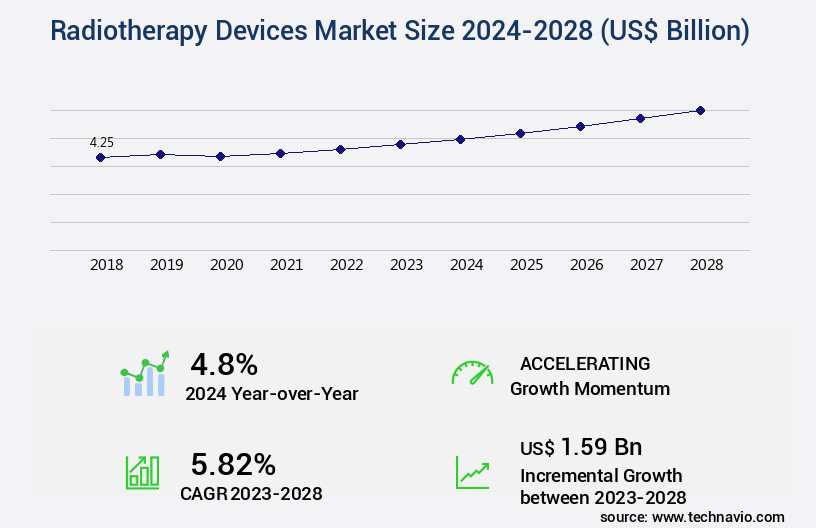
Get Key Insights on Market Forecast (PDF) Request Free Sample
How is the Radiotherapy Devices Market Segmented ?
The radiotherapy devices industry research report provides comprehensive data (region-wise segment analysis), with forecasts and estimates in "USD billion" for the period 2024-2028, as well as historical data from 2018-2022 for the following segments.
- End-user
- Hospitals
- Ambulatory surgical centers
- Oncological treatment centers
- Product
- External beam radiation therapy device
- Internal beam radiation therapy device
- Geography
- North America
- Europe
- APAC
- Rest of World (ROW)
By End-user Insights
The hospitals segment is estimated to witness significant growth during the forecast period.
Radiotherapy, a sophisticated treatment modality for managing various health conditions, particularly cancer, is witnessing continuous evolution in hospitals, which serve as the primary consumers due to their substantial resources. These institutions house specialized oncology departments or cancer centers, where advanced radiotherapy devices are employed to deliver precise radiation doses to tumors, minimizing damage to healthy tissues. The integration of these devices in healthcare facilities brings numerous advantages. They enhance treatment precision through technologies like radiation dose calculation, image-guided radiotherapy, and stereototactic radiosurgery. Patient safety is prioritized with radiation protection protocols and treatment delivery systems. Radiotherapy planning and response assessment tools, such as treatment planning software and 3D conformal radiotherapy, contribute to improved patient outcomes.
Furthermore, advanced techniques like intensity modulated radiotherapy, adaptive radiotherapy, and oncology workflow optimization streamline treatment delivery and increase efficiency. According to a recent report, the global radiotherapy market is projected to reach a value of USD16.4 billion by 2025, underscoring the growing importance of this technology in healthcare.
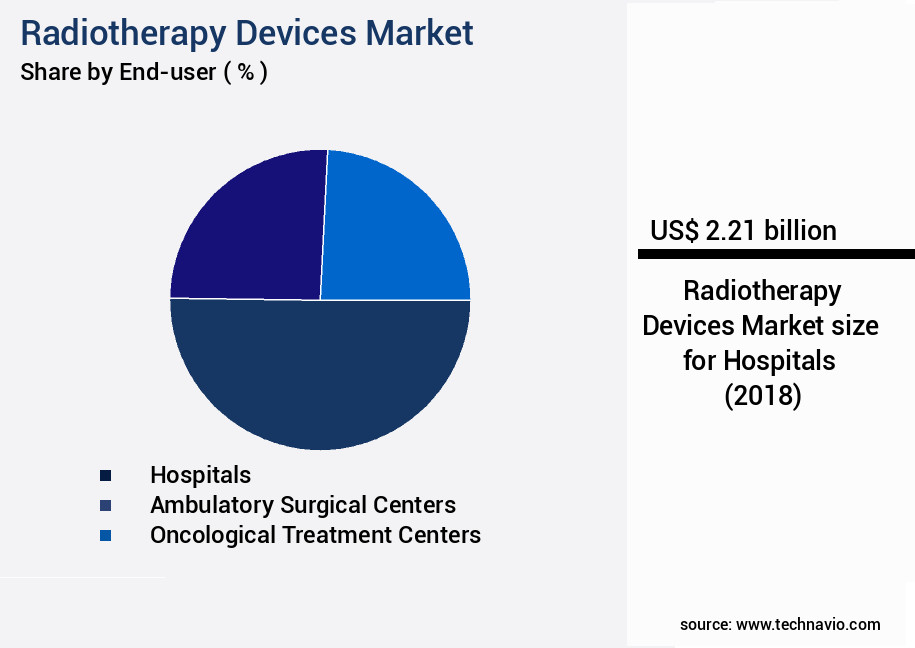
Request Free Sample
The Hospitals segment was valued at USD 2.21 billion in 2018 and showed a gradual increase during the forecast period.
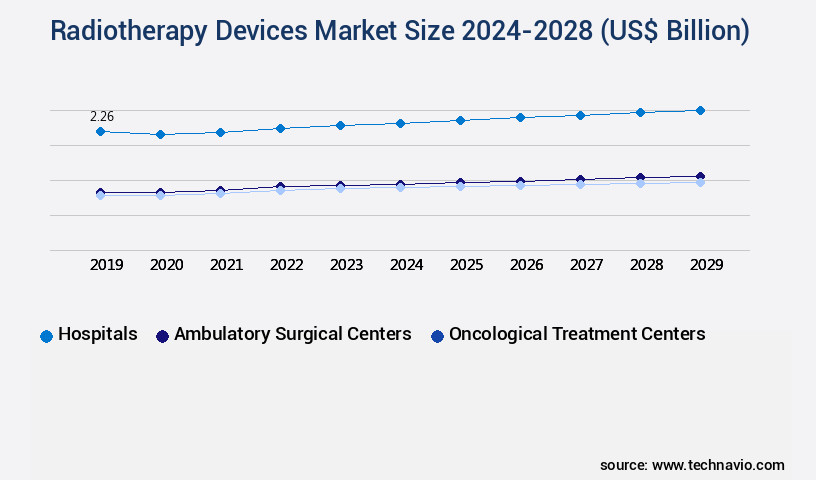
Request Free Sample
Regional Analysis
North America is estimated to contribute 43% to the growth of the global market during the forecast period.Technavio's analysts have elaborately explained the regional trends and drivers that shape the market during the forecast period.
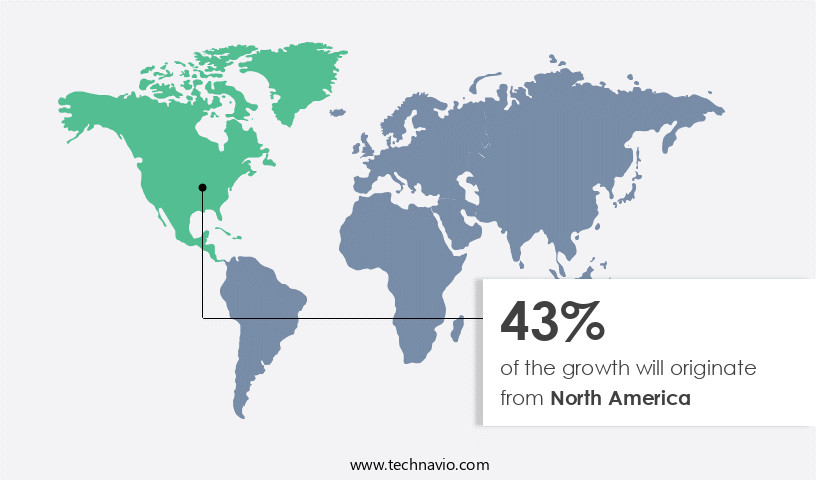
See How Radiotherapy Devices Market Demand is Rising in North America Request Free Sample
The market is witnessing significant growth, with North America leading the global landscape in terms of revenue in 2023. The US, being the major contributor to the market in the region, is also the world's largest market for radiation therapy. With the largest installed base of radiotherapy devices, the US market's growth is driven by several factors. These include the increasing incidence of cancer, the presence of numerous multinational companies, the rising number of radiotherapy procedures, and the availability of advanced healthcare infrastructure.
The adoption of technologically advanced radiation therapy devices and substantial healthcare expenditure further fuel the market's expansion. In North America, the US is not the only significant player; Canada also contributes significantly to the market's growth. This region's dominance is a testament to its robust healthcare sector and the increasing focus on cancer treatment.
Market Dynamics
Our researchers analyzed the data with 2023 as the base year, along with the key drivers, trends, and challenges. A holistic analysis of drivers will help companies refine their marketing strategies to gain a competitive advantage.
The market is experiencing significant growth due to the increasing prevalence of cancer and the ongoing advancements in radiotherapy techniques. One of the key trends in this market is the adoption of advanced radiotherapy techniques, such as proton therapy and intensity modulated radiotherapy (IMRT), which offer more precise and personalized treatments. Proton therapy dose calculation and image guided radiotherapy systems are essential components of these advanced techniques, ensuring accurate delivery of radiation doses to the tumor site while minimizing exposure to healthy tissue. Linear accelerator maintenance is a critical aspect of ensuring the reliability and accuracy of these systems, as they are the primary tools for delivering external beam radiotherapy. Brachytherapy, another form of radiotherapy, is also gaining popularity due to its ability to deliver high doses of radiation directly to the tumor site. Brachytherapy seed placement techniques have been improved through the use of radiation therapy treatment planning software and oncology data management systems, enabling more precise and effective treatments. Stereotactic body radiotherapy workflow and 3D conformal radiotherapy optimization are other advanced techniques that require sophisticated technology for radiation therapy patient positioning, treatment response evaluation methods, and radiation dosimetry calculation methods. Radiation therapy quality assurance protocols and radiation protection standards compliance are essential to ensure the safety and efficacy of these treatments. Remote afterloading brachytherapy systems and electronic brachytherapy systems are also gaining traction in the market, offering increased convenience and precision medicine for patients. External beam radiotherapy techniques continue to be the backbone of radiotherapy treatment, and advancements in tumor targeting technology and radiation therapy patient positioning are driving innovation in this area. Overall, the market is poised for continued growth as the demand for more precise and effective cancer treatments increases.
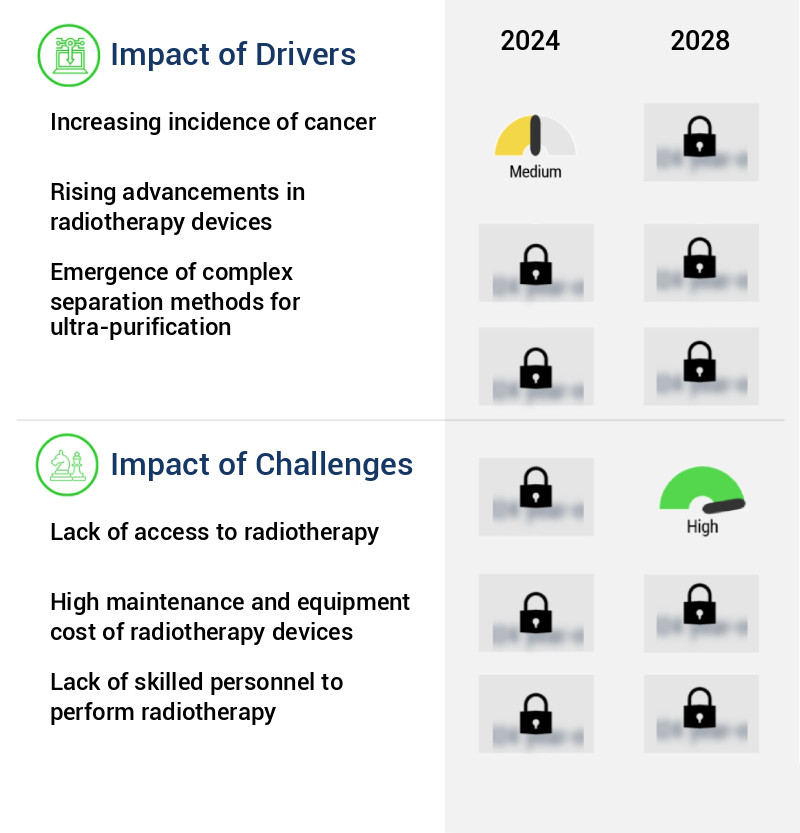
What are the key market drivers leading to the rise in the adoption of Radiotherapy Devices Industry?
- The rising prevalence of cancer serves as the primary catalyst for market growth.
- The market is experiencing significant growth due to the increasing incidence and prevalence of various types of cancers, such as lung, breast, prostate, colorectal, and stomach. For instance, the European Commission reported an estimated 3.5 million cancer cases in Europe alone in 2020. The demand for advanced medical procedures to cure cancer or alleviate associated pain is on the rise, leading to a surging need for radiation therapy as a treatment approach.
- This increasing need to address the rising incidences of cancer is expected to fuel the growth of the market.
What are the market trends shaping the Radiotherapy Devices Industry?
- In emerging economies, the rising growth potential represents the prevailing market trend.
- The market is experiencing significant evolution, driven by the increasing prevalence of cancer and favorable government initiatives. This growth is particularly noticeable in emerging economies, such as China and India, where substantial market opportunities exist due to the expanding healthcare sector. The healthcare industry in these countries is growing rapidly, fueled by increasing healthcare expenditure. The allure of these markets lies in the low cost of raw materials used for advanced radiotherapy devices and relatively low labor costs, which are attracting new entrants and established companies to expand their presence.
- Developing countries like India and China represent a largely untapped market for radiotherapy devices, offering substantial growth potential.
What challenges does the Radiotherapy Devices Industry face during its growth?
- The absence of radiotherapy access poses a significant challenge to the industry's growth trajectory.
- The market is evolving, with increasing demand driven by the growing prevalence of cancer and advancements in technology. Despite this, access to radiotherapy remains limited due to a shortage of investments and resources. Approximately 90% of all cancer patients in low-income countries lack access to radiotherapy services. The global standard for cancer care recommends one radiation megavoltage machine for every 150,000 people in a region. However, many countries, particularly in Africa, have no radiotherapy devices. For instance, Senegal, Ghana, South Africa, and Ethiopia face severe shortages.
- The market is expected to continue growing, with advancements in technologies like Intensity-Modulated Radiation Therapy (IMRT) and Image-Guided Radiation Therapy (IGRT) driving demand. The market's potential is vast, with opportunities for growth in emerging economies and the development of more cost-effective solutions.
Exclusive Technavio Analysis on Customer Landscape
The radiotherapy devices market forecasting report includes the adoption lifecycle of the market, covering from the innovator's stage to the laggard's stage. It focuses on adoption rates in different regions based on penetration. Furthermore, the radiotherapy devices market report also includes key purchase criteria and drivers of price sensitivity to help companies evaluate and develop their market growth analysis strategies.
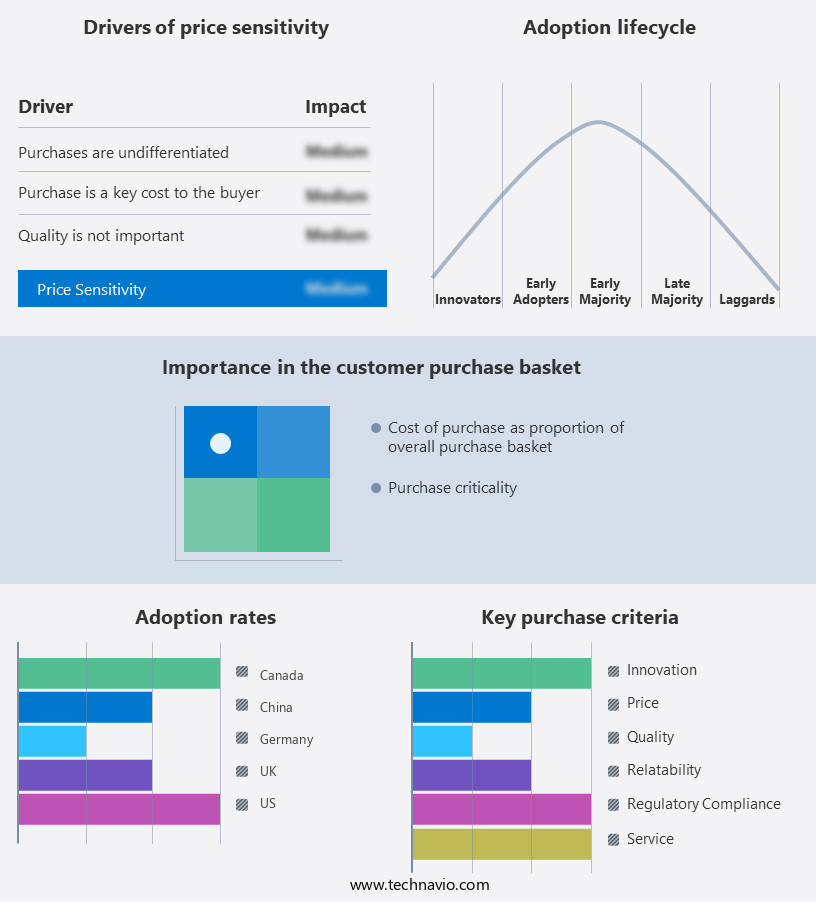
Customer Landscape of Radiotherapy Devices Industry
Competitive Landscape
Companies are implementing various strategies, such as strategic alliances, radiotherapy devices market forecast, partnerships, mergers and acquisitions, geographical expansion, and product/service launches, to enhance their presence in the industry.
Accuray Inc. - This company specializes in advanced radiotherapy technology, providing solutions like the CyberKnife S7 and Radixact systems. These devices employ precise, targeted radiation therapy to effectively treat various types of cancer, enhancing patient outcomes and improving overall treatment efficiency.
The industry research and growth report includes detailed analyses of the competitive landscape of the market and information about key companies, including:
- Accuray Inc.
- AngioDynamics Inc.
- Becton Dickinson and Co.
- Eckert and Ziegler AG
- Elekta AB
- GE Healthcare Technologies Inc.
- Hitachi Ltd.
- iCAD Inc.
- Ion Beam Applications SA
- IsoRay, Inc.
- Koninklijke Philips N.V.
- Mitsubishi Heavy Industries Ltd.
- Nasdaq Inc.
- Neusoft Corp.
- Shinva Medical Instrument Co., Ltd.
- Siemens Healthineers AG
- Theragenics Corp.
- Toshiba Corp.
- ViewRay Inc.
- Vision RT Ltd.
Qualitative and quantitative analysis of companies has been conducted to help clients understand the wider business environment as well as the strengths and weaknesses of key industry players. Data is qualitatively analyzed to categorize companies as pure play, category-focused, industry-focused, and diversified; it is quantitatively analyzed to categorize companies as dominant, leading, strong, tentative, and weak.
Recent Development and News in Radiotherapy Devices Market
- In January 2024, Elekta AB, a leading innovator of radiation therapy systems, announced the launch of its new Agility Multi-Leaf Collimator (MLC), which offers enhanced precision and efficiency for radiotherapy treatments. This development was disclosed in Elekta's official press release (Elekta.Com).
- In March 2024, Varian Healthcare, a prominent player in the market, entered into a strategic partnership with Memorial Sloan Kettering Cancer Center to integrate Varian's AI-driven treatment planning solutions into the renowned cancer center's clinical workflows. The collaboration was revealed in a Varian press release (Varian.Com).
- In May 2024, Ion Beam Applications S.A., a global leader in proton therapy systems, secured a significant investment of €150 million from a consortium of investors to support the expansion of its manufacturing capabilities and accelerate the commercialization of its proton therapy technology. The investment was reported by Reuters.
- In April 2025, Accuray Incorporated, a leading provider of radiosurgery and stereotactic body radiotherapy systems, received FDA approval for its CyberKnife System with the new Synchrony Respiratory Motion Tracking System, enabling more precise and effective lung cancer treatments. The approval was announced in Accuray's press release (Accuray.Com).
Dive into Technavio's robust research methodology, blending expert interviews, extensive data synthesis, and validated models for unparalleled Radiotherapy Devices Market insights. See full methodology.
|
Market Scope
|
|
Report Coverage
|
Details
|
|
Page number
|
158
|
|
Base year
|
2023
|
|
Historic period
|
2018-2022 |
|
Forecast period
|
2024-2028
|
|
Growth momentum & CAGR
|
Accelerate at a CAGR of 5.82%
|
|
Market growth 2024-2028
|
USD 1.59 billion
|
|
Market structure
|
Fragmented
|
|
YoY growth 2023-2024(%)
|
4.8
|
|
Key countries
|
US, Canada, UK, Germany, and China
|
|
Competitive landscape
|
Leading Companies, Market Positioning of Companies, Competitive Strategies, and Industry Risks
|
Request Free Sample
Research Analyst Overview
- The market continues to evolve, driven by advancements in technology and growing applications across various sectors. Radiation dose calculation and dosimetry calculations are crucial components of treatment planning, ensuring precise delivery of radiation doses to target areas. Gamma knife radiosurgery and stereotactic radiosurgery are non-invasive techniques that utilize precise radiation delivery, while image-guided radiotherapy and radiation therapy planning enable real-time monitoring of tumor locations. Linear accelerator technology and tomotherapy systems are essential tools for external beam radiotherapy, offering intensity modulated radiotherapy and treatment fractionation. Proton beam therapy and electron beam therapy provide alternative approaches for tumor targeting, while brachytherapy techniques, including HDR and LDR, offer localized radiation delivery.
- Radiation protection and safety protocols are paramount in the field, with remote afterloading systems and patient positioning systems ensuring accurate and safe treatment delivery. Radiotherapy simulation and 3D conformal radiotherapy enable personalized treatment plans, while treatment monitoring systems facilitate ongoing assessment of treatment response. The radiotherapy market is projected to grow at a robust rate, with industry experts estimating a 10% annual expansion. For instance, a leading cancer center reported a 15% increase in patients undergoing radiation therapy in the past year. The ongoing integration of radiobiology principles, treatment delivery systems, and oncology workflow optimization continues to reshape the market landscape.
What are the Key Data Covered in this Radiotherapy Devices Market Research and Growth Report?
-
What is the expected growth of the Radiotherapy Devices Market between 2024 and 2028?
-
What segmentation does the market report cover?
-
The report is segmented by End-user (Hospitals, Ambulatory surgical centers, and Oncological treatment centers), Product (External beam radiation therapy device and Internal beam radiation therapy device), and Geography (North America, Europe, Asia, and Rest of World (ROW))
-
Which regions are analyzed in the report?
-
What are the key growth drivers and market challenges?
-
Who are the major players in the Radiotherapy Devices Market?
-
Accuray Inc., AngioDynamics Inc., Becton Dickinson and Co., Eckert and Ziegler AG, Elekta AB, GE Healthcare Technologies Inc., Hitachi Ltd., iCAD Inc., Ion Beam Applications SA, IsoRay, Inc., Koninklijke Philips N.V., Mitsubishi Heavy Industries Ltd., Nasdaq Inc., Neusoft Corp., Shinva Medical Instrument Co., Ltd., Siemens Healthineers AG, Theragenics Corp., Toshiba Corp., ViewRay Inc., and Vision RT Ltd.
Market Research Insights
- The market is a continually advancing field, encompassing various technologies and applications. Two significant aspects of this industry are the increasing emphasis on patient education and treatment planning, with an estimated 70% of radiation oncology practices utilizing oncology informatics systems to streamline these processes. Furthermore, radiation protection measures and safety compliance standards remain a priority, as evidenced by the industry's commitment to ensuring a 10% annual reduction in treatment side effects. These improvements contribute to the overall growth of the market, with expectations projecting a steady expansion in the coming years.
- For instance, the integration of advanced medical imaging techniques, such as CT and MRI, in treatment planning and delivery systems, has led to improved patient outcomes and increased sales for manufacturers.
We can help! Our analysts can customize this radiotherapy devices market research report to meet your requirements.
Get in touch
1 Executive Summary
- 1.1 Market overview
- Exhibit 01: Executive Summary – Chart on Market Overview
- Exhibit 02: Executive Summary – Data Table on Market Overview
- Exhibit 03: Executive Summary – Chart on Global Market Characteristics
- Exhibit 04: Executive Summary – Chart on Market by Geography
- Exhibit 05: Executive Summary – Chart on Market Segmentation by End-user
- Exhibit 06: Executive Summary – Chart on Market Segmentation by Product
- Exhibit 07: Executive Summary – Chart on Incremental Growth
- Exhibit 08: Executive Summary – Data Table on Incremental Growth
- Exhibit 09: Executive Summary – Chart on Vendor Market Positioning
2 Market Landscape
- 2.1 Market ecosystem
- Exhibit 10: Parent market
- Exhibit 11: Market Characteristics
3 Market Sizing
- 3.1 Market definition
- Exhibit 12: Offerings of vendors included in the market definition
- 3.2 Market segment analysis
- Exhibit 13: Market segments
- 3.4 Market outlook: Forecast for 2023-2028
- Exhibit 14: Chart on Global - Market size and forecast 2023-2028 ($ billion)
- Exhibit 15: Data Table on Global - Market size and forecast 2023-2028 ($ billion)
- Exhibit 16: Chart on Global Market: Year-over-year growth 2023-2028 (%)
- Exhibit 17: Data Table on Global Market: Year-over-year growth 2023-2028 (%)
4 Historic Market Size
- 4.1 Global radiotherapy devices market 2018 - 2022
- Exhibit 18: Historic Market Size – Data Table on global radiotherapy devices market 2018 - 2022 ($ billion)
- 4.2 End-user Segment Analysis 2018 - 2022
- Exhibit 19: Historic Market Size – End-user Segment 2018 - 2022 ($ billion)
- 4.3 Product Segment Analysis 2018 - 2022
- Exhibit 20: Historic Market Size – Product Segment 2018 - 2022 ($ billion)
- 4.4 Geography Segment Analysis 2018 - 2022
- Exhibit 21: Historic Market Size – Geography Segment 2018 - 2022 ($ billion)
- 4.5 Country Segment Analysis 2018 - 2022
- Exhibit 22: Historic Market Size – Country Segment 2018 - 2022 ($ billion)
5 Five Forces Analysis
- 5.1 Five forces summary
- Exhibit 23: Five forces analysis - Comparison between 2023 and 2028
- 5.2 Bargaining power of buyers
- Exhibit 24: Chart on Bargaining power of buyers – Impact of key factors 2023 and 2028
- 5.3 Bargaining power of suppliers
- Exhibit 25: Bargaining power of suppliers – Impact of key factors in 2023 and 2028
- 5.4 Threat of new entrants
- Exhibit 26: Threat of new entrants – Impact of key factors in 2023 and 2028
- 5.5 Threat of substitutes
- Exhibit 27: Threat of substitutes – Impact of key factors in 2023 and 2028
- 5.6 Threat of rivalry
- Exhibit 28: Threat of rivalry – Impact of key factors in 2023 and 2028
- 5.7 Market condition
- Exhibit 29: Chart on Market condition - Five forces 2023 and 2028
6 Market Segmentation by End-user
- 6.1 Market segments
- Exhibit 30: Chart on End-user - Market share 2023-2028 (%)
- Exhibit 31: Data Table on End-user - Market share 2023-2028 (%)
- 6.2 Comparison by End-user
- Exhibit 32: Chart on Comparison by End-user
- Exhibit 33: Data Table on Comparison by End-user
- 6.3 Hospitals - Market size and forecast 2023-2028
- Exhibit 34: Chart on Hospitals - Market size and forecast 2023-2028 ($ billion)
- Exhibit 35: Data Table on Hospitals - Market size and forecast 2023-2028 ($ billion)
- Exhibit 36: Chart on Hospitals - Year-over-year growth 2023-2028 (%)
- Exhibit 37: Data Table on Hospitals - Year-over-year growth 2023-2028 (%)
- 6.4 Ambulatory surgical centers - Market size and forecast 2023-2028
- Exhibit 38: Chart on Ambulatory surgical centers - Market size and forecast 2023-2028 ($ billion)
- Exhibit 39: Data Table on Ambulatory surgical centers - Market size and forecast 2023-2028 ($ billion)
- Exhibit 40: Chart on Ambulatory surgical centers - Year-over-year growth 2023-2028 (%)
- Exhibit 41: Data Table on Ambulatory surgical centers - Year-over-year growth 2023-2028 (%)
- 6.5 Oncological treatment centers - Market size and forecast 2023-2028
- Exhibit 42: Chart on Oncological treatment centers - Market size and forecast 2023-2028 ($ billion)
- Exhibit 43: Data Table on Oncological treatment centers - Market size and forecast 2023-2028 ($ billion)
- Exhibit 44: Chart on Oncological treatment centers - Year-over-year growth 2023-2028 (%)
- Exhibit 45: Data Table on Oncological treatment centers - Year-over-year growth 2023-2028 (%)
- 6.6 Market opportunity by End-user
- Exhibit 46: Market opportunity by End-user ($ billion)
- Exhibit 47: Data Table on Market opportunity by End-user ($ billion)
7 Market Segmentation by Product
- 7.1 Market segments
- Exhibit 48: Chart on Product - Market share 2023-2028 (%)
- Exhibit 49: Data Table on Product - Market share 2023-2028 (%)
- 7.2 Comparison by Product
- Exhibit 50: Chart on Comparison by Product
- Exhibit 51: Data Table on Comparison by Product
- 7.3 External beam radiation therapy device - Market size and forecast 2023-2028
- Exhibit 52: Chart on External beam radiation therapy device - Market size and forecast 2023-2028 ($ billion)
- Exhibit 53: Data Table on External beam radiation therapy device - Market size and forecast 2023-2028 ($ billion)
- Exhibit 54: Chart on External beam radiation therapy device - Year-over-year growth 2023-2028 (%)
- Exhibit 55: Data Table on External beam radiation therapy device - Year-over-year growth 2023-2028 (%)
- 7.4 Internal beam radiation therapy device - Market size and forecast 2023-2028
- Exhibit 56: Chart on Internal beam radiation therapy device - Market size and forecast 2023-2028 ($ billion)
- Exhibit 57: Data Table on Internal beam radiation therapy device - Market size and forecast 2023-2028 ($ billion)
- Exhibit 58: Chart on Internal beam radiation therapy device - Year-over-year growth 2023-2028 (%)
- Exhibit 59: Data Table on Internal beam radiation therapy device - Year-over-year growth 2023-2028 (%)
- 7.5 Market opportunity by Product
- Exhibit 60: Market opportunity by Product ($ billion)
- Exhibit 61: Data Table on Market opportunity by Product ($ billion)
8 Customer Landscape
- 8.1 Customer landscape overview
- Exhibit 62: Analysis of price sensitivity, lifecycle, customer purchase basket, adoption rates, and purchase criteria
9 Geographic Landscape
- 9.1 Geographic segmentation
- Exhibit 63: Chart on Market share by geography 2023-2028 (%)
- Exhibit 64: Data Table on Market share by geography 2023-2028 (%)
- 9.2 Geographic comparison
- Exhibit 65: Chart on Geographic comparison
- Exhibit 66: Data Table on Geographic comparison
- 9.3 North America - Market size and forecast 2023-2028
- Exhibit 67: Chart on North America - Market size and forecast 2023-2028 ($ billion)
- Exhibit 68: Data Table on North America - Market size and forecast 2023-2028 ($ billion)
- Exhibit 69: Chart on North America - Year-over-year growth 2023-2028 (%)
- Exhibit 70: Data Table on North America - Year-over-year growth 2023-2028 (%)
- 9.4 Europe - Market size and forecast 2023-2028
- Exhibit 71: Chart on Europe - Market size and forecast 2023-2028 ($ billion)
- Exhibit 72: Data Table on Europe - Market size and forecast 2023-2028 ($ billion)
- Exhibit 73: Chart on Europe - Year-over-year growth 2023-2028 (%)
- Exhibit 74: Data Table on Europe - Year-over-year growth 2023-2028 (%)
- 9.5 Asia - Market size and forecast 2023-2028
- Exhibit 75: Chart on Asia - Market size and forecast 2023-2028 ($ billion)
- Exhibit 76: Data Table on Asia - Market size and forecast 2023-2028 ($ billion)
- Exhibit 77: Chart on Asia - Year-over-year growth 2023-2028 (%)
- Exhibit 78: Data Table on Asia - Year-over-year growth 2023-2028 (%)
- 9.6 Rest of World (ROW) - Market size and forecast 2023-2028
- Exhibit 79: Chart on Rest of World (ROW) - Market size and forecast 2023-2028 ($ billion)
- Exhibit 80: Data Table on Rest of World (ROW) - Market size and forecast 2023-2028 ($ billion)
- Exhibit 81: Chart on Rest of World (ROW) - Year-over-year growth 2023-2028 (%)
- Exhibit 82: Data Table on Rest of World (ROW) - Year-over-year growth 2023-2028 (%)
- 9.7 US - Market size and forecast 2023-2028
- Exhibit 83: Chart on US - Market size and forecast 2023-2028 ($ billion)
- Exhibit 84: Data Table on US - Market size and forecast 2023-2028 ($ billion)
- Exhibit 85: Chart on US - Year-over-year growth 2023-2028 (%)
- Exhibit 86: Data Table on US - Year-over-year growth 2023-2028 (%)
- 9.8 China - Market size and forecast 2023-2028
- Exhibit 87: Chart on China - Market size and forecast 2023-2028 ($ billion)
- Exhibit 88: Data Table on China - Market size and forecast 2023-2028 ($ billion)
- Exhibit 89: Chart on China - Year-over-year growth 2023-2028 (%)
- Exhibit 90: Data Table on China - Year-over-year growth 2023-2028 (%)
- 9.9 UK - Market size and forecast 2023-2028
- Exhibit 91: Chart on UK - Market size and forecast 2023-2028 ($ billion)
- Exhibit 92: Data Table on UK - Market size and forecast 2023-2028 ($ billion)
- Exhibit 93: Chart on UK - Year-over-year growth 2023-2028 (%)
- Exhibit 94: Data Table on UK - Year-over-year growth 2023-2028 (%)
- 9.10 Canada - Market size and forecast 2023-2028
- Exhibit 95: Chart on Canada - Market size and forecast 2023-2028 ($ billion)
- Exhibit 96: Data Table on Canada - Market size and forecast 2023-2028 ($ billion)
- Exhibit 97: Chart on Canada - Year-over-year growth 2023-2028 (%)
- Exhibit 98: Data Table on Canada - Year-over-year growth 2023-2028 (%)
- 9.11 Germany - Market size and forecast 2023-2028
- Exhibit 99: Chart on Germany - Market size and forecast 2023-2028 ($ billion)
- Exhibit 100: Data Table on Germany - Market size and forecast 2023-2028 ($ billion)
- Exhibit 101: Chart on Germany - Year-over-year growth 2023-2028 (%)
- Exhibit 102: Data Table on Germany - Year-over-year growth 2023-2028 (%)
- 9.12 Market opportunity by geography
- Exhibit 103: Market opportunity by geography ($ billion)
- Exhibit 104: Data Tables on Market opportunity by geography ($ billion)
10 Drivers, Challenges, and Trends
- 10.3 Impact of drivers and challenges
- Exhibit 105: Impact of drivers and challenges in 2023 and 2028
11 Vendor Landscape
- 11.2 Vendor landscape
- Exhibit 106: Overview on Criticality of inputs and Factors of differentiation
- 11.3 Landscape disruption
- Exhibit 107: Overview on factors of disruption
- 11.4 Industry risks
- Exhibit 108: Impact of key risks on business
12 Vendor Analysis
- 12.1 Vendors covered
- Exhibit 109: Vendors covered
- 12.2 Market positioning of vendors
- Exhibit 110: Matrix on vendor position and classification
- 12.3 Accuray Inc.
- Exhibit 111: Accuray Inc. - Overview
- Exhibit 112: Accuray Inc. - Product / Service
- Exhibit 113: Accuray Inc. - Key news
- Exhibit 114: Accuray Inc. - Key offerings
- 12.4 Becton Dickinson and Co.
- Exhibit 115: Becton Dickinson and Co. - Overview
- Exhibit 116: Becton Dickinson and Co. - Business segments
- Exhibit 117: Becton Dickinson and Co. - Key news
- Exhibit 118: Becton Dickinson and Co. - Key offerings
- Exhibit 119: Becton Dickinson and Co. - Segment focus
- 12.5 Eckert and Ziegler AG
- Exhibit 120: Eckert and Ziegler AG - Overview
- Exhibit 121: Eckert and Ziegler AG - Business segments
- Exhibit 122: Eckert and Ziegler AG - Key news
- Exhibit 123: Eckert and Ziegler AG - Key offerings
- Exhibit 124: Eckert and Ziegler AG - Segment focus
- 12.6 Elekta AB
- Exhibit 125: Elekta AB - Overview
- Exhibit 126: Elekta AB - Business segments
- Exhibit 127: Elekta AB - Key news
- Exhibit 128: Elekta AB - Key offerings
- Exhibit 129: Elekta AB - Segment focus
- 12.7 GE Healthcare Technologies Inc.
- Exhibit 130: GE Healthcare Technologies Inc. - Overview
- Exhibit 131: GE Healthcare Technologies Inc. - Business segments
- Exhibit 132: GE Healthcare Technologies Inc. - Key offerings
- Exhibit 133: GE Healthcare Technologies Inc. - Segment focus
- 12.8 Hitachi Ltd.
- Exhibit 134: Hitachi Ltd. - Overview
- Exhibit 135: Hitachi Ltd. - Business segments
- Exhibit 136: Hitachi Ltd. - Key news
- Exhibit 137: Hitachi Ltd. - Key offerings
- Exhibit 138: Hitachi Ltd. - Segment focus
- 12.9 iCAD Inc.
- Exhibit 139: iCAD Inc. - Overview
- Exhibit 140: iCAD Inc. - Business segments
- Exhibit 141: iCAD Inc. - Key offerings
- Exhibit 142: iCAD Inc. - Segment focus
- 12.10 Ion Beam Applications SA
- Exhibit 143: Ion Beam Applications SA - Overview
- Exhibit 144: Ion Beam Applications SA - Business segments
- Exhibit 145: Ion Beam Applications SA - Key offerings
- Exhibit 146: Ion Beam Applications SA - Segment focus
- 12.11 IsoRay, Inc.
- Exhibit 147: IsoRay, Inc. - Overview
- Exhibit 148: IsoRay, Inc. - Product / Service
- Exhibit 149: IsoRay, Inc. - Key offerings
- 12.12 Koninklijke Philips N.V.
- Exhibit 150: Koninklijke Philips N.V. - Overview
- Exhibit 151: Koninklijke Philips N.V. - Business segments
- Exhibit 152: Koninklijke Philips N.V. - Key news
- Exhibit 153: Koninklijke Philips N.V. - Key offerings
- Exhibit 154: Koninklijke Philips N.V. - Segment focus
- 12.13 Nasdaq Inc.
- Exhibit 155: Nasdaq Inc. - Overview
- Exhibit 156: Nasdaq Inc. - Product / Service
- Exhibit 157: Nasdaq Inc. - Key offerings
- 12.14 Shinva Medical Instrument Co., Ltd.
- Exhibit 158: Shinva Medical Instrument Co., Ltd. - Overview
- Exhibit 159: Shinva Medical Instrument Co., Ltd. - Product / Service
- Exhibit 160: Shinva Medical Instrument Co., Ltd. - Key offerings
- 12.15 Siemens Healthineers AG
- Exhibit 161: Siemens Healthineers AG - Overview
- Exhibit 162: Siemens Healthineers AG - Business segments
- Exhibit 163: Siemens Healthineers AG - Key news
- Exhibit 164: Siemens Healthineers AG - Key offerings
- Exhibit 165: Siemens Healthineers AG - Segment focus
- 12.16 ViewRay Inc.
- Exhibit 166: ViewRay Inc. - Overview
- Exhibit 167: ViewRay Inc. - Product / Service
- Exhibit 168: ViewRay Inc. - Key offerings
- 12.17 Vision RT Ltd.
- Exhibit 169: Vision RT Ltd. - Overview
- Exhibit 170: Vision RT Ltd. - Product / Service
- Exhibit 171: Vision RT Ltd. - Key offerings
13 Appendix
- 13.2 Inclusions and exclusions checklist
- Exhibit 172: Inclusions checklist
- Exhibit 173: Exclusions checklist
- 13.3 Currency conversion rates for US$
- Exhibit 174: Currency conversion rates for US$
- 13.4 Research methodology
- Exhibit 175: Research methodology
- Exhibit 176: Validation techniques employed for market sizing
- Exhibit 177: Information sources
- 13.5 List of abbreviations
- Exhibit 178: List of abbreviations







![]() Get the report (PDF) sent to your email within minutes.
Get the report (PDF) sent to your email within minutes.
Complimentary full Excel data with your report purchase.